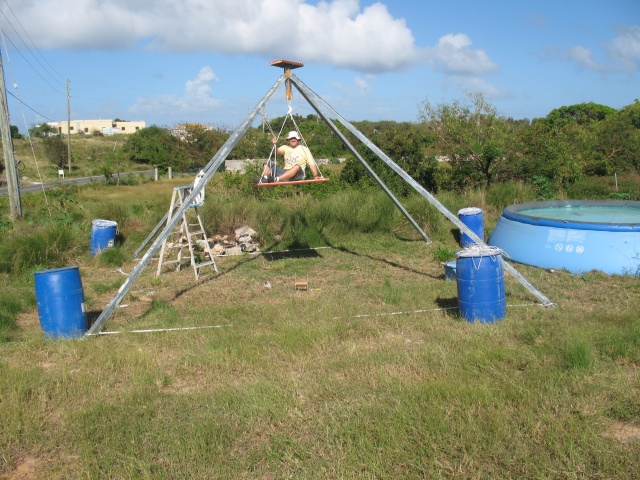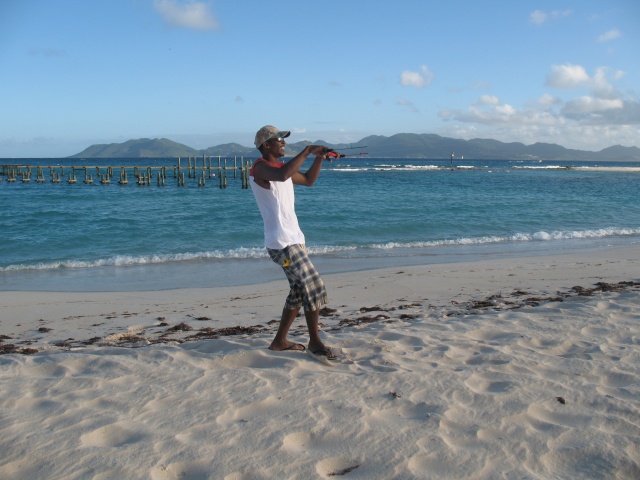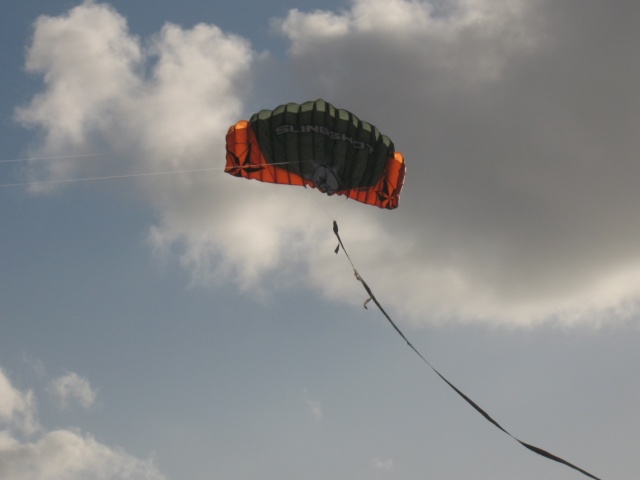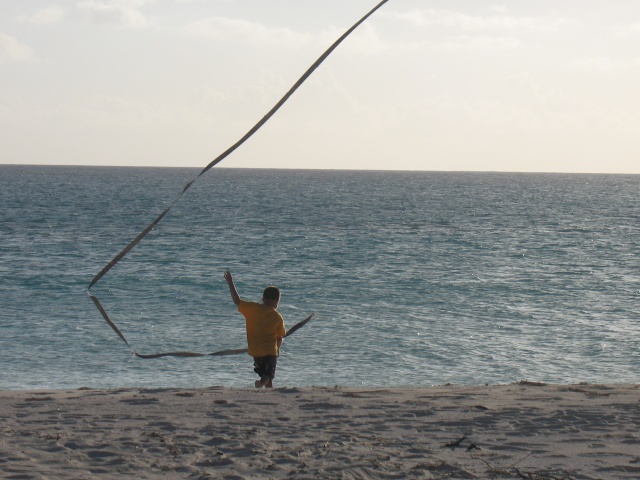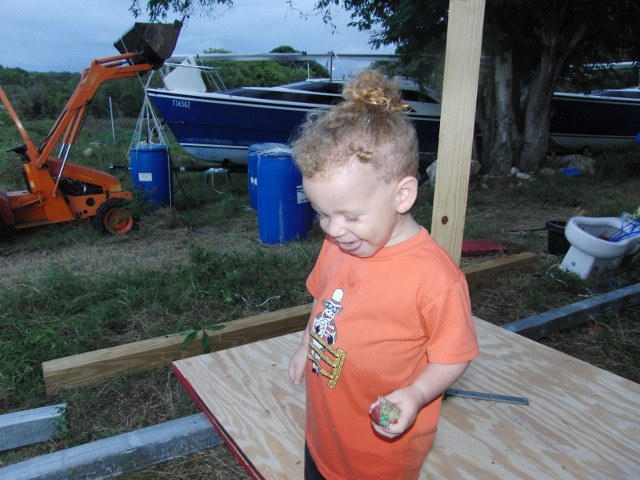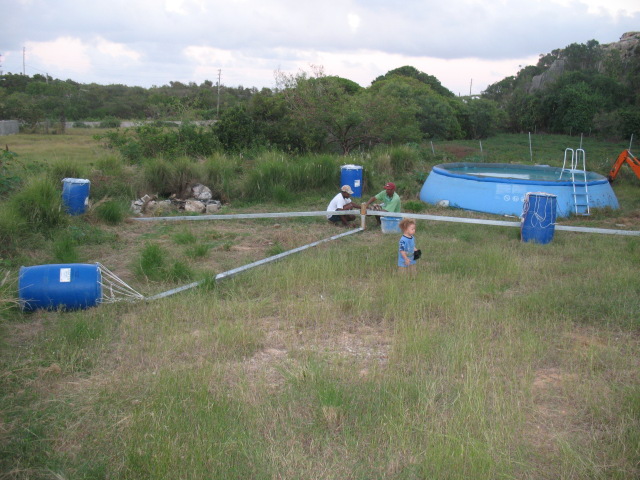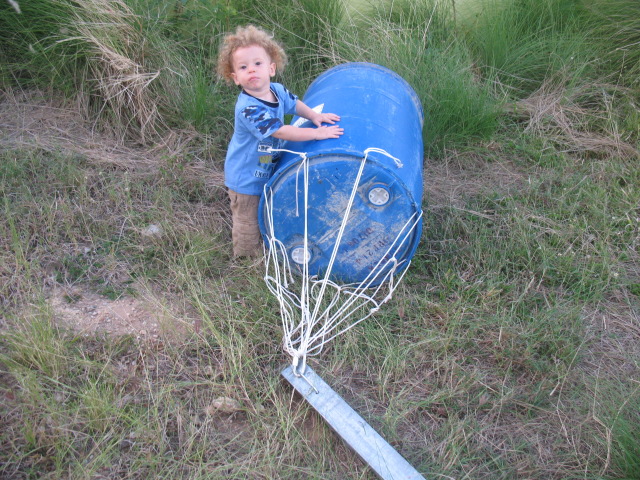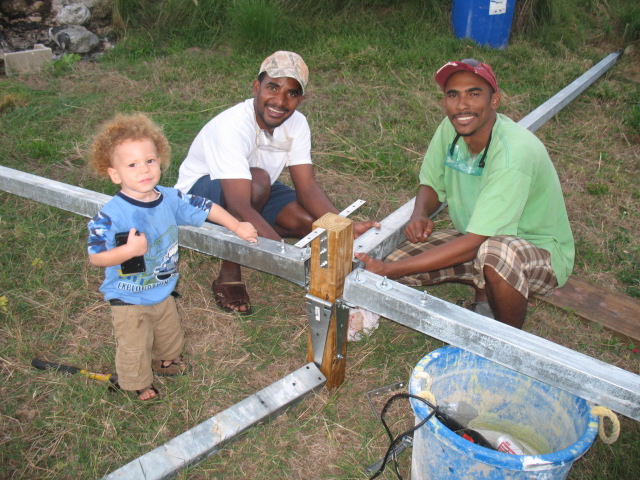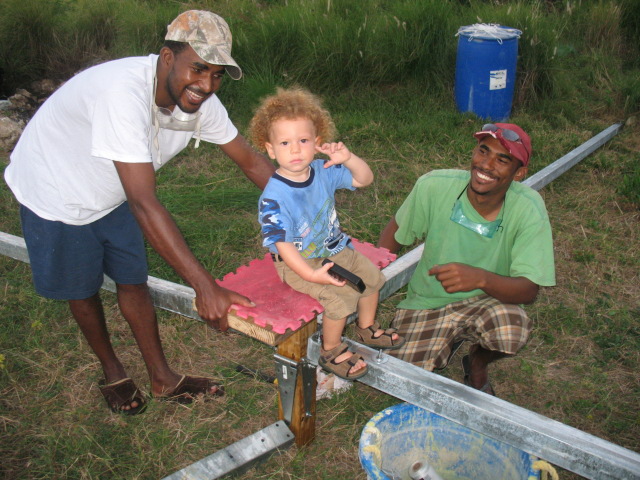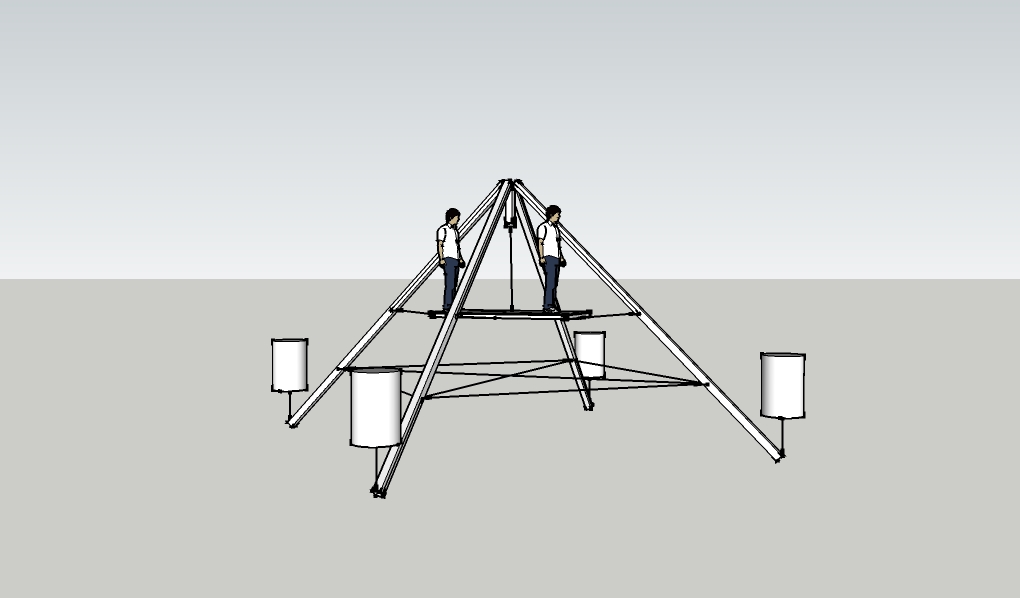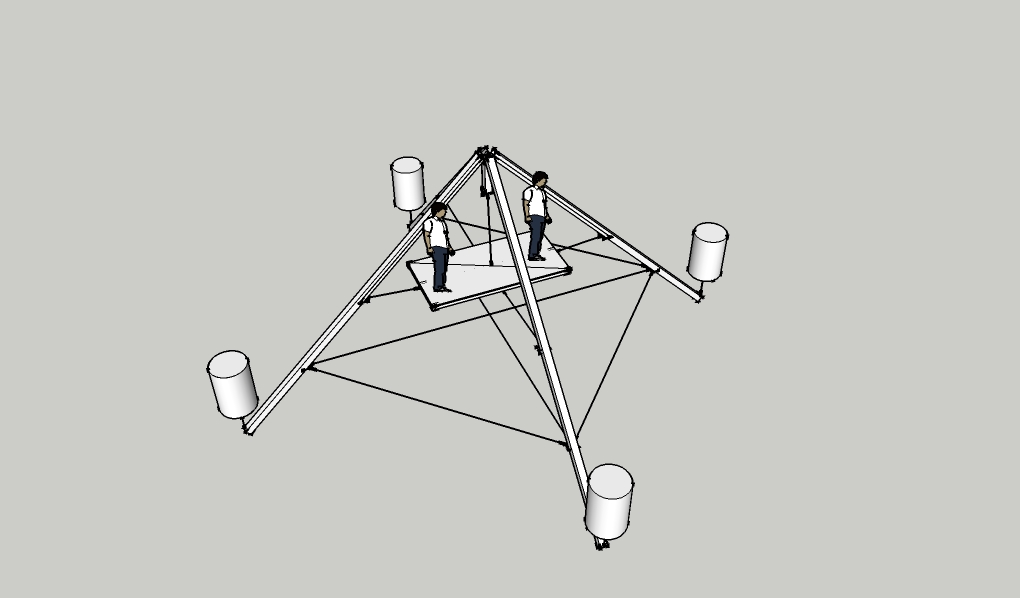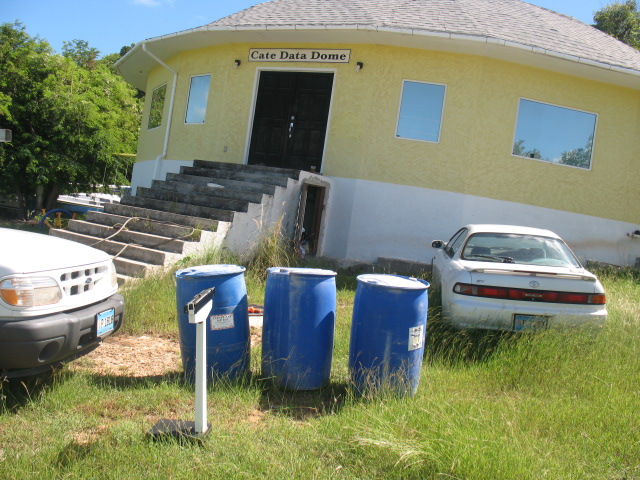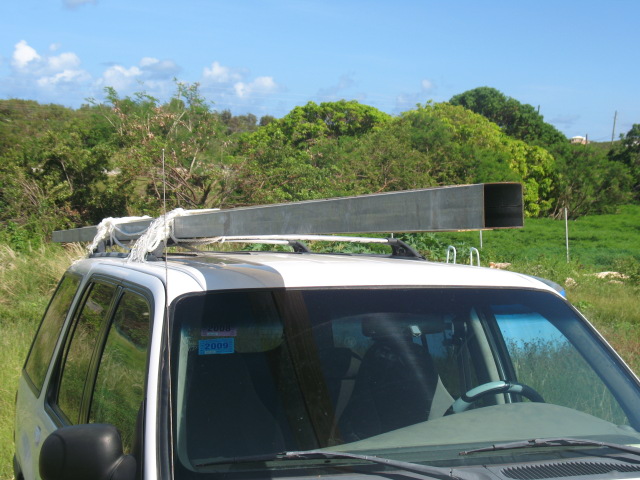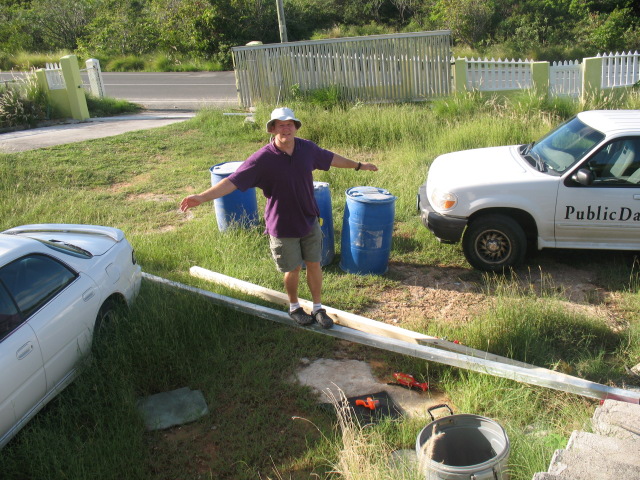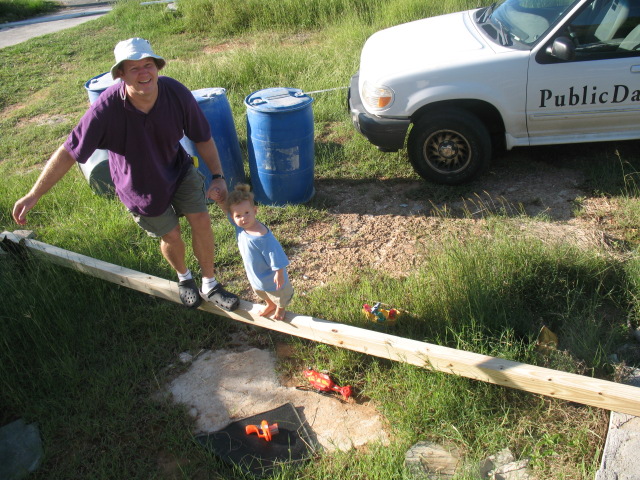User:Vincecate/WaterWalker2
Building a 1:5 scale model/prototype like the WaterWalker model that is big enough for 2 people to take a kite powered ride along the South side of Anguilla. The legs will be 20 feet long. I have done several seastead models but this will be the first large enough to play on.
/Image:WaterWalker2WithKite.JPG
Contents
Costs
- Main Rope - $108.59 - 150 feet of 3/4 inch nylon rope
- Barrels - $80 - 4 from a West Indies Concrete in Anguilla at $20 each
- Steel Beams - $212 - 4 steel box-beams at $53 each (called "3-inch square tubing" at the store)
- Hardware - $120 - hinges, nuts, bolts, L-brackets, washers, small rope
- Wood beam - ~$20
- Plywood - $35
The barrels are a great deal. The rope price does not include shipping and duty. The other prices are tropical island prices which include shipping and duty - US prices should be less for these things.
Weights
- Barrels 20 lbs
- 3" square tube 20 feet long - 48 lbs
- 4x4 at 16 feet long - 60 lbs
- 4x4 at 20 feet long - 75 lbs
Flotation
The barrels are 54 gallons which is 432 lbs in fresh water and a bit more in salt water. The plastic underwater should float so only about half of the 20 lbs of the barrel really counts, or 10 lbs. The ropes holding the base in shape will probably be underwater and should nearly float.
- Flotation 1783 lbs (from 4 barrels in salt water)
- Using half each 891 lbs
- Weight of beams 192 lbs (4 metal beams)
- Weight of half of barrels out of water - 40 lbs
- Weight of misc 100 lbs (short central beam, platform, and various hardware)
- Available for people and other cargo 559 lbs
Might fill lower part of steel tubes with foam so they float. This would add a bit extra flotation.
If we had an aluminum box beam that was thick enough to weld to we could close off the end and make something to attach to at the same time. A 6 inch square aluminum box beam would be great. Aluminum is a better choice for a production model but it costs much more so I am not using it for this prototype.
Design Decisions
There have been several design decisions that I puzzled over.
- Going from 3 legs to 4. I did this because it gives me a wider base and lets me use 4 of the cheap barrels I have available. With this I am sure I can carry 2 people and maybe more. Makes structure a bit more complex.
- How to join the legs together at the top. With 4 legs the 4 hinge method on a central column seems good. But it is a potential weak link.
- With 4 legs it makes sense to have diagonal ropes between the legs but I think this is not really needed. Without the diagonals opposite sides can move in or out while other pair does opposite. Should be limited range though as weight is transfered to legs coming together. Might reduce passenger motion. A WaterWalker with moving legs seems fun to try. Makes tying the platform not so easy, but might be OK without ties.
- Ropes out of the water or at ends of legs? If the ropes are out of the water there is less drag for the structure moving through the water; however, the stress on the leg is more. If the ropes are in the water they can help to attract fish. Can also use the same attachment point used to tie barrels. Expect to tie at ends of legs.
- Height/width ratio. If the structure is wider it is more stable, but there is more stress on the beams and ropes. With ropes at ends there is less stress on beams and I can make structure wider before breaking anything. I also think there is less risk of trouble from leaving off the diagonal ropes if the structure is very wide.
- How to make platform for people. Don't want it to be too heavy but people need to be able to hang out for the whole trip. Decided on a small seat at the very top and a 4' by 4' platform about 4 feet down from joint. Can lean on the legs while standing. Attaching both with L brackets.
- How to attach the barrels
- Strap barrels along end of the leg - no movement or danger of hitting leg but bigger waterline area
- Tie them so they float horizontally with tail fin so line up in direction of movement - could reduce drag when moving through the water. Complicated with what I have.
- Tie them so they float in normal barrel orientation (vertical) - minimizes waterline area - some danger of barrel hitting leg. With ropes and legs in the water heave should not be too much of a problem. Choice I made.
Sponsors
After this has been built, tested in the ocean, and documented on the web, these sponsors have pledged these amounts:
- Joep - $300
- Jesrad - $200
Route for Maiden Voyage
My current plan is to do a 2 to 4 mile route that is mostly downwind and never far from land. Will go into the water at one beach and then get out of the water at another beach 2.5 miles over, or maybe the West end of that beach for a 3 mile trip, or if things are going really well a beach even further for about 4 miles. The wind is normally from the East and we will do this on a day when that is so. Will have a person in Hobie Outback nearby and may change people during trip. The kayak may pull the model a bit south at the start if the kite has any trouble pulling the model south enough to clear land 1/2 mile from start.
If we can average 1/2 MPH then it would be about 5 hours to make the 2.5 miles. At 1:5 scale this is simulating a 12.5 mile trip at 1.12 MPH.
Things to bring on maiden voyage
* Life jackets for everyone (3 to 5) * Swimming fins * Sun screen * Water/drinks/cooler/food * 2 or 3 people on board model 1 or 2 people in kayak * Sea Anchor - test how much it slows model down * Kite/pulley/attachment-rope, maybe backup kite * Cell phones in dry bags * waterproof camera and cheap camera in dry bag, expensive camera on land with tripod * GPS - map, to record route, see how much off downwind we can go, how fast * Paper chart, print of Google maps in dry bag * Fishing pole/hooks/bait-squid/container * Kayak/paddles/pedals * Extra rope * Log-book and pen * Something to put between structure legs to make shade on platform (maybe sea anchor) * Extra batteries * Hand radios
Maiden Voyage Results
Miguel and Vacquelin did most of the construction for WaterWalker2. They were home from college for Christmas and heading back on Jan 8th. So the last day to launch was Jan 7th and we were in a hurry to do so. Vacquelin is the one who has done any really pretty sketchup drawing that I have posted.
<youtube v="AdEjM69Htj8" />
GPS / Speed / Angle
We took a GPS on the trip and the GPS data is online. It says that we did 654 feet at a heading of 249 degrees. This is probably about right and means we did like 21 degrees South of West when the wind was going West. The kite was probably pulling us more like 45 degrees south of West. Our track was a compromise of the wind push and the kite pull. The GPS says we did this 654 feet in 12 seconds, but really it was like 3.5 minutes which would be 3.1 feet/second or 2.1 MPH. This is faster than predicted.
Worked Well
- Hinge was fine. Never saw a time where opposite legs were trying to lean in opposite ways and so twisting the hinges.
- The structure is very stable. More stable than 50 person ferries nearby. No danger of tipping over or a leg folding under.
- The barrels could move in the waves without moving the structure much.
- There was no need for diagonal ropes
- Rope underwater was always straight (in tension) unless on a rock
- Barrels did not hit the metal legs as they moved in waves
Not so well
- The force from the wind on the structure was larger than expected. Really not practical for the pedal kayak (which really does pull well) to pull the model with the strong winds we had. Even the small dingy that pulled us off the rocks had a hard time moving us.
- Because of the drag we could not go as far to the left or right of downwind as predicted
- The wooden platform we stood on was suspended by ropes and could rotate. Even though the metal structure of the model was really stable what we were standing on was not. It meant we basically had to hold on all the time.
- We should have used a location that would be fine even if we drifted with the wind.
Possible things to work on next for this project
- Have other possible passengers practice with my kites while on land
- Measure force/speed for barrel in pool - barrel half full of water - both on side and upright
- Measure force/speed for 4x4 section in pool
- Measure thrust lbs from Hobie Outback
- Measure force from kite
- Model 4 leg WaterWalker to test if we really need diagonal ropes (I no longer think we need them)
- I have pulled my 2500 lb boat (really 3600 lbs with water ballast) with my kayak, this at 1/10th the weight but less hydrodynamic is probably similar really. So I am sure I can move it with a kite or kayak. But question is how fast. If it was 1 MPH or more I might do an 8 mile trip instead of 2.5 miles. On the other hand it may be good to start with a small trip. I also need to measure how far off-wind I can travel before trying the longer trip and I can only do this on a test voyage.
- Just build it and launch it
Major results from experiment
- How fast kite moves model
- Single kite
- Kite flying in figure-8
- Multiple kites at once
- How fast Hobbie Outback moves model
- Largest angle left or right of downwind that we can do with kite
- How 4 legs works without diagonal bracing ropes (moving leg WaterWalker)
- Expect ropes to always stay taught so each of the 4 faces on the pyramid stays the same area
- Think a wave hitting a leg sideways still does not torque hinge in bad way
- Think there is never any danger of tipping over or a leg folding under
Construction Progress
Is Vince the first human sitting on something called a "seastead"? If so this historic event was Jan 6, 2009. My next seastead will have more floor space.
Miguel flying a 2-string kite for the first time and doing well. We are checking out 2 kites that had not been used in 10 years and training the crew. This location is where we plan to start the maiden voyage from.
This kite is about 5 feet wide but seems to get up 20 to 30 lbs pull when flown in figure-8 in typical Anguilla wind. We put a long tail on to reduce the chance of crashing.
My son Teryn is chasing after the tail.
Amoni checking out the 4' by 4' lower platform with central column. Since this picture I decided to just suspend the platform with ropes from the corners to a short center column and the nearest leg. Was worried about stress on hinges, in particular if the legs are moving and attached to the platform.
In the background are the 4 barrels. One is filled with 400 lbs of water and suspended from the backhoe to test the rope connections to the barrel - seems fine.
Looks like it is going to be big!
Shows how ropes attach barrel to leg. Rope going around legs will go through the same thing on the leg.
Amoni, Vacquelin and Miguel getting the parts together. We needed extra washers to pad the bolts as they were just a bit too long and ran out of washers before we could finish and lift it up in the air.
Vacquelin, Amoni, and Miguel checking out "crows nest" seat.
Other Pictures
Got these 3 barrels for $20 each from the concrete plant. Now planning on using 4.
This 3" by 3" square tube is 20 feet long and cost me $53. Tropical island prices include shipping and duty, so are usually nearly twice mainland prices. I just got one so far to make sure I can work with the ends and that it is strong enough.
Testing 20 foot steel box-beam (square tubing) with 250 lbs on it.
Testing 16 foot 4x4 with nearly 300 lbs on it. The extra weight came on of its own accord.
